 February 16, 2017 -
February 16, 2017 -
Spanish-American War
Philippine Insurrection
“Remember The Maine”
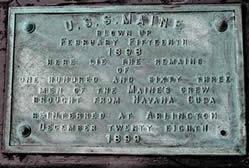 Soon after riots broke out in Havana, Cuba in January, 1898 the battleship USS Maine set sail to protect American interests although the Secretary of the Navy, John D. Long insisted it was only making a friendly call. On February 15th, 1898, a mysterious explosion destroyed the Maine while moored in the harbor of Havana that resulted in the loss of 266 crewmen and marines. Although the explosion remained a mystery the American public reacted with outrage blaming Spain for the disaster. Congress passed a joint resolution recognizing Cuban independence and demanding Spanish withdrawal from Cuba, which was signed by President William McKinley the following day. When Spain then broke off relations with the United States congress declared on April 25th, 1898 that a state of war had existed between them since April 21st. The war lasted less than four months and was very one sided as Spain was not ready to take on a powerful country like the United States. The Spanish fleet was destroyed on the morning of May 1st, 1898 in Manila Bay, Philippines with only seven American seamen wounded. Manila was then occupied by US troops. The Treaty of Paris was signed on December 10th, 1898 when Spain gave up all claim to Cuba, ceded Guam and Puerto Rico to the US and transferred sovereignty over the Philippines to the United States for $20M.
Soon after riots broke out in Havana, Cuba in January, 1898 the battleship USS Maine set sail to protect American interests although the Secretary of the Navy, John D. Long insisted it was only making a friendly call. On February 15th, 1898, a mysterious explosion destroyed the Maine while moored in the harbor of Havana that resulted in the loss of 266 crewmen and marines. Although the explosion remained a mystery the American public reacted with outrage blaming Spain for the disaster. Congress passed a joint resolution recognizing Cuban independence and demanding Spanish withdrawal from Cuba, which was signed by President William McKinley the following day. When Spain then broke off relations with the United States congress declared on April 25th, 1898 that a state of war had existed between them since April 21st. The war lasted less than four months and was very one sided as Spain was not ready to take on a powerful country like the United States. The Spanish fleet was destroyed on the morning of May 1st, 1898 in Manila Bay, Philippines with only seven American seamen wounded. Manila was then occupied by US troops. The Treaty of Paris was signed on December 10th, 1898 when Spain gave up all claim to Cuba, ceded Guam and Puerto Rico to the US and transferred sovereignty over the Philippines to the United States for $20M.
During the Spanish-American War the United States and Filipino forces had a common enemy in Spain. In the Treaty of Paris, the US obtained ownership of the Philippines and President McKinley made it clear that the Philippines would not be granted independence. As a result, Filipino rebels began an armed resistance against the United States. The Philippine Insurrection began with a skirmish on the night of February 4, 1899, just outside of Manila and the fighting continued until President Theodore Roosevelt proclaimed an end to the insurrection on July 4th, 1902. There were however isolated and sporadic guerilla activity that lasted until 1946 when the Philippines finally gained their independence.
Three veterans from Shelby County, Texas are known to have served in the Spanish-American War and one would go on to also serve in the Philippine Insurrection.
Bronson Cline was born in Michigan on October 31, 1876 to a father from New York and a mother from Pennsylvania. He enlisted with the 2nd Louisiana Volunteer Infantry on May 24th, 1898 and arrived in Cuba two days after Christmas that same year and took part in the Santiago Campaign. His unit returned to the United States in March, 1899 and he was honorably discharged on June 22nd, 1899. He then owned a farm in Shelbyville with wife Lillie Goodson Cline (1898-1990) and raised three daughters, Jean, Kathleen and Virginia along with two sons, Joe and James. On September 12th, 1918 at the age of 42 he registered for the World War I draft but was not called to serve. The 1930 census showed his address as Precinct 2, Logansport and East Hamilton Road, Shelby County, Texas. He lived a long life and passed on March 2, 1969 at the age of 93. He is buried in the Carroll Cemetery here in Shelby County. He was awarded the U. S. Army Spanish Campaign Medal for his service.
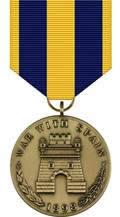

Born in Panola County on July 15th, 1872 to Seth and Lizzie Barber Hudson, Charles Henry Hudson began his military service with Company A., 1st Regiment, Texas Infantry. He married Julia Ann in the year 1897 and enlisted a year later June 25th, 1898. He then served in Cuba until he was mustered out on November 15th. After discharge he lived on his farm in Timpson with Julia and son Lem Carlton “Joe.” He died of a heart attack on February 24th, 1949 at the age of 77 and is buried in the Corinth Cemetery, Timpson, Texas. For his service, he too was awarded the U. S. Army Spanish Campaign Medal.

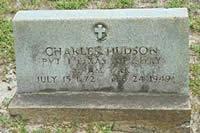
Elijah Webb was a Shelby County native, born in the year 1866. His father was Anthony Webb and mother Mary Jane McNeil Webb. The exact date he joined Company H. of the 44th US Volunteer Infantry is not known but his unit was sent to Cuba and then ordered to Manila in the Philippines. During the fighting in the Philippines Elijah was killed in action on June 16th, 1900 and his remains were returned to Shelby County for reburial in August, 1901. The Houston Post had a short article that said in part “on the large box which held the metallic coffin was his name, the number of his company and the cause of his death, which as stated on the box was a knife wound in the head.” It went on to say “Lige had many friends here and a good crowd witnessed the casket in which rested his remains. He was buried in the Center Cemetery.” The Center Cemetery is now known as the Methodist Cemetery and is located behind the First United Methodist Church on Porter Street here in Center. Elijah was awarded the Purple Heart, Spanish Campaign Medal and the Philippine Campaign Medal.


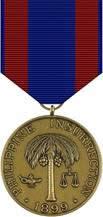
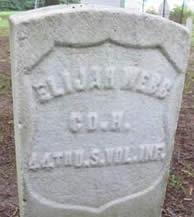 The Spanish-American War and the Philippine Insurrection that followed claimed the lives of 3,000 Americans but much of that number died of yellow fever and typhoid. Teddy Roosevelt of Roughrider fame told his troops as they mustered out, “enjoy the next 15 days because after that you will be forgotten.” He was right, the troops came home still suffering and because of the United States Government’s refusal of proper medical care, these veterans banded together in organizations that would eventually become the Veterans of Foreign Wars of the United States. Today, so many years since, we continue to fight for veteran’s rights.
The Spanish-American War and the Philippine Insurrection that followed claimed the lives of 3,000 Americans but much of that number died of yellow fever and typhoid. Teddy Roosevelt of Roughrider fame told his troops as they mustered out, “enjoy the next 15 days because after that you will be forgotten.” He was right, the troops came home still suffering and because of the United States Government’s refusal of proper medical care, these veterans banded together in organizations that would eventually become the Veterans of Foreign Wars of the United States. Today, so many years since, we continue to fight for veteran’s rights.
A few days ago, on Wednesday, February 15th, 2017 Shelby County Memorial VFW Post 8904 and the Auxiliary held a remembrance program and wreath laying for these veterans. No group of veterans should ever be forgotten regardless of time passed and we vow to never let that happen. We hope you feel the same and will consider attending one or more of our 21 observances during the year. If you can add to the story of these veterans, please contact me at 936-598-2976 or email chief@chiefimaging.com.
(Sources: Library of Congress, “The Spanish-American War in Motion Pictures” Feb, 2017; History.com, Spanish-American War, Feb, 2017; Military.com Philippine Insurrection, Feb, 2017; Ancestry.com, Feb, 2017; Texas Military Forces Museum.org, Feb, 2017; Texas State Library, Feb, 2017; Houston Post, Aug 18, 1901; Plaque Photo courtesy of Dan West)









